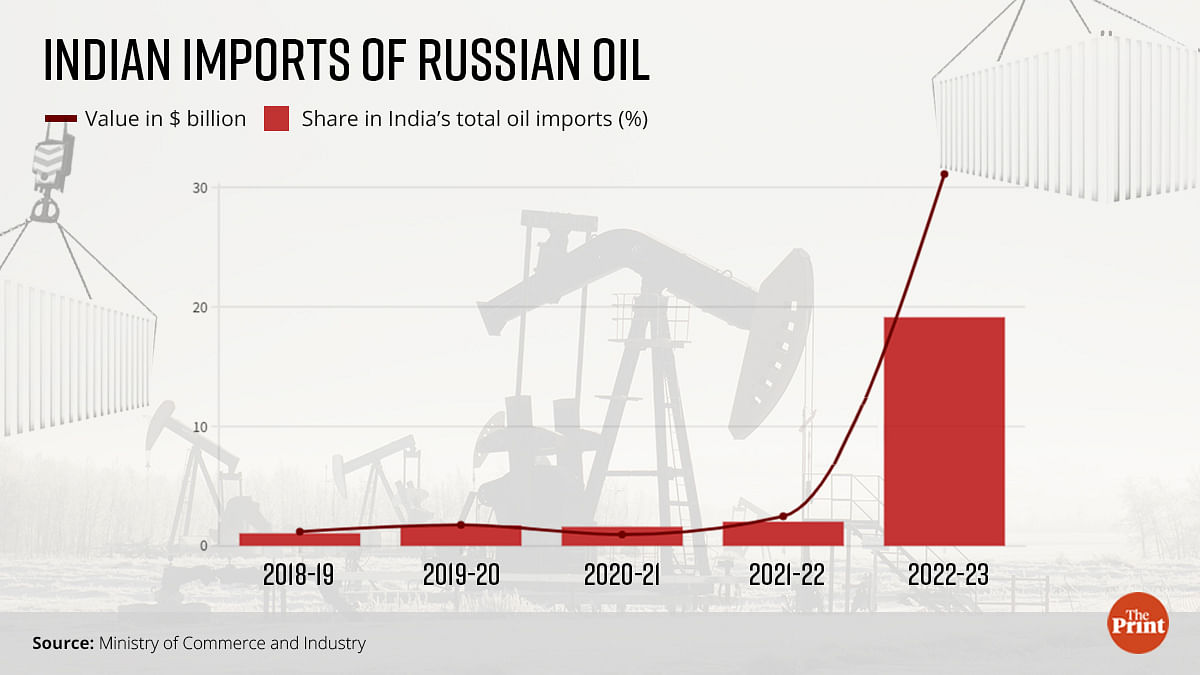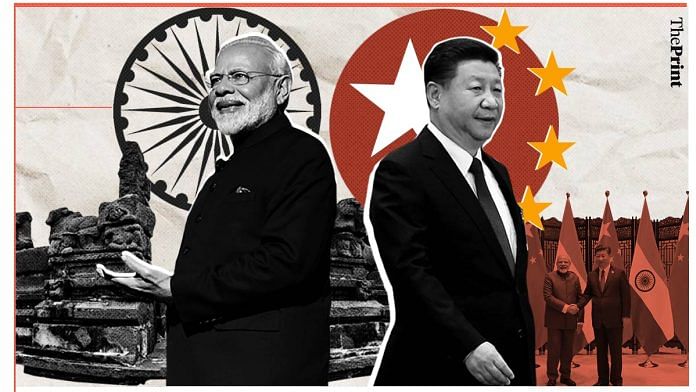New Delhi: India is making about 10 percent of its payments for Russian oil in the Chinese yuan, ThePrint has learnt, with the rest of the payments being made in Indian rupees and UAE dirhams.
The US and European sanctions and oil price caps imposed on Russia in the aftermath of its invasion of Ukraine has resulted in two major changes in the way India goes about importing its crude oil requirement.
The first change was the sharp increase in India’s oil imports from Russia, with India taking advantage of the discounts being offered by Russia.
The second change has to do with how India pays for this oil — having to rely on alternate currencies, as Russia can no longer do business in the US dollar, the currency in which payments were earlier being made.
ThePrint had previously reported that India had started paying for Russian oil using dirhams, but that experts were of the view that this alternative would be short-lived because Russia was accumulating more dirhams that it could use.
In fact, this was the reason rupee payments to Russia were also not working out.
In April, in a statement to news agency ANI, Denis Valentinovich Manturov, Russia’s deputy prime minister and minister for industry and trade, said that “because of a lack of imports from India, it’s not enough to use the rupee”.
This statement came as a contradiction to hopes expressed by some economists and commentators that the rupee could emerge as a viable alternative to the dollar in a period where several economies are looking to “de-dollarise”.
Meanwhile, China’s exports to Russia jumped nearly 70 percent in the first three months of 2023 calendar year, coming in at $33.7 billion. In comparison, the total trade — both imports and exports — between India and Russia in the 2022-23 financial year stood at $39.8 billion.
This shows the relative ease with which Russia can accept the yuan as payment, as opposed to the rupee. In short, Russia has more avenues to spend the yuan than it does the rupee.
As recently as April, experts had said that Russia would not push India to make payments in yuan given the tensions between India and China. The Indian government has also been pushing back against having to pay in yuan. However, both Russia’s compunctions and India’s resistance don’t seem to be holding up any longer.
“Payments to Russia in yuan are happening,” a senior official in the Ministry of Petroleum and Natural Gas (MoPNG) confirmed to ThePrint on condition of anonymity, given the sensitivity of the matter.
“ICICI Bank was already doing it for Reliance. But now some public sector banks have also started [for other oil marketing companies],” the official added. The official, however, did not specify which public sector banks were conducting the yuan transactions.
ThePrint has reached both ICICI Bank and Reliance Industries over emails, calls, and messages to confirm this, but has not received a response till the time of publishing of this report.
The petroleum ministry official confirmed that while payments were being made in rupees and dirhams, the process was taking time and payments to Russian entities were getting delayed.
“Russia has told our oil marketing companies that they are okay with the delays, but then at least some of the payment should be in a currency they can use,” the official quoted above said.
“And so yuan payments have started, but only for about 10 percent of how much we pay for Russian oil,” the official added.
A senior official in the Ministry of Finance explained that India has a small reserve of yuan, which it is using for the payments to Russia.
When contacted for an official comment over email, the Ministry of Finance spokesperson said: “You’re requested to reach out to the MoPNG for inputs to this story as DEA (Department of Economic Affairs) carries out only the policy and not the operational part of the above process.”
ThePrint is awaiting responses to queries posed to MoPNG through email. This report will be updated when a response is received.
The Ministry of External Affairs declined to comment on how payments in yuan reconciled with India’s tense relationship with China, especially following the Galwan Valley clash in 2020.
Also Read: Time ripe for ‘de-dollarisation’? Not yet, say central bank officials in new international survey
Skyrocketing Russian oil imports
According to Ministry of Commerce and Industry data, India’s imports of Russian oil skyrocketed in 2022-23, both in absolute terms and also as in terms of Russia’s share in India’s overall oil imports.

India’s imports of oil from Russia jumped from $2.47 billion in 2021-22 to a massive $31.12 billion in 2022-23, according to the data — a more than 1,100 percent increase in one year. This has taken Russia’s share in India’s overall oil imports to 19.1 percent in 2022-23, up from just two percent in the previous year.
If India were to continue paying for 10 percent of its Russian oil imports using the yuan, and assuming oil imports from Russia remain the same in 2023-24 as they were in 2022-23, this would mean India’s yuan payments would be equivalent to $3.1 billion over the year.
“Even though India has a big trade deficit with China, we do export some amount to that country and so we have a reserve of yuan,” the finance ministry official quoted above explained, when asked where India was getting its yuan from.
A second senior finance ministry official explained that India’s public sector oil marketing companies and public sector banks have historically been reluctant to break sanction orders, which means that all transactions with Russia are being done in accordance with the rules.
“Even when it came to sanctions on Iran, it was the government companies that pushed back against anything that might break the sanction rules,” the official said.
“In the case of Russia as well, all payments are being made in accordance with the rules,” the second finance ministry official added.
(With input from Shreya Shankar)
(Edited by Anumeha Saxena)
Also Read: Modi’s India lost an opportunity by hosting SCO summit online with Xi, Putin, Sharif



